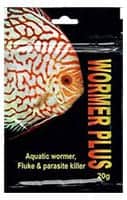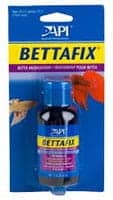
Discus velvet disease is treated using aquarium salt, by raising the tank’s water temperature, changing the tank water, using methylene blue, and making sure that the condition of the tank water in which discus resides is best.
Table of Contents
- Discus Velvet Disease
- What Does Velvet Disease Look Like?
- Discus Velvet Symptoms
- Discus Velvet Description And Causes
- Discus Velvet Treatment Steps
- [STEP1] – Do A Partial Water Change
- [STEP2] – Clean Your Tank
- [STEP3] – Check The Water Condition Of The Tank & Make Adjustments If Needed
- [STEP4] – Increase Water Temperature
- [STEP5] – Dim The Room’s Light Or Turn Them Off Completely
- [STEP6] – Remove The Active Carbon Filter
- [STEP7] – Treating Velvet With Salt
- [STEP8] – Treat with Blue Planet’s Multi-Cure
- [STEP9] – Treat With Medicine
- [STEP10] – Treat with Bettafix
- [STEP11] – Cover The Tank
- Does Paraguard treat Velvet?
- Future Prevention Tips
- Conclusion
Discus Velvet Disease
Discus velvet disease is an ailment that is caused by a parasite of the genus Oodinium which attaches itself to the body, gills, and fins of a Discus. Infected Discus fish begins to scratch itself against objects (a reaction referred to as flashing), their fins become clamped, and they become weak.
What Does Velvet Disease Look Like?
When discus is suffering from a condition of velvet disease, its skin will appear dusty and somewhat yellowish. This is basically the way the infection reveals itself, as a grey-yellow colour on the body of the fish, and this colour of appearance is why velvet disease is also called rust disease or gold-dust disease.
Discus Velvet Symptoms
Velvet disease is calumnious to Discus, so be sure to observe your fishes daily to see if you’ll notice any of the following symptoms:
- When the infection is at its early stages, your Discus will twitch its fins or rub its body against objects or surfaces like plants.
- The body of the Discus begins to appear dusty and opaque, this is as a result of the generation of surplus mucus by the immune system of the Discus to tackle the disease.
- The eyes of Discus become opaque.
- Discus begins to show signs of skin ulcer.
- Discus begins to suffer exophthalmia.
- The fins of Discus become clamped against its body.
- Discus begins to show signs of weakness or lethargy.
- If the disease becomes severe, Discus will begin to have difficulty in breathing (rapid breathing) and may die of hypoxia.
- Loss of appetite, as well as weight.
- Gill tissue in discus will suffer necrosis.
- A severe infection will cause the skin of Discus to peel off.
Discus Velvet Description And Causes
Is Velvet a bacterial infection?
Velvet is not an infection caused by bacteria; rather, it is a disease that is caused by the parasite of the genus, Oodinium. It causes grey-yellow spots to appear on the body of the discus or any other fish, and that is why it is often referred to as the gold-dust or rust disease.
What Causes Velvet?
Velvet is caused by a parasite dinoflagellate known as Oodinium. It has a round or oval shape, it attacks all kinds of fish but mostly ornamental fishes, and it is one major cause of mortality in fish offspring.
Some of the things that make fishes vulnerable to the disease include; poor quality of water, irregularity of water temperature, poor handling of the fishes, and a dirty tank – all these put Discus fishes under a lot of stress, and when fishes are stressed, their immune systems become weak.
Further Clarifications
There are three species that can cause velvet disease to a Discua fish, they are pillularis, limneticum and ocellatum, they produce the same symptoms, and their lifecycle is alike with that of the parasite known as ich.
Oodinium pilluralis is the causative agent of velvet disease in freshwater (tanks and aquariums); it is a parasite that attaches itself to the body, gills, and fins of discus and it is sometimes called rust or gold-dust disease.
The lifecycle of Oodimium can be split into three stages:
Stage 1 – in the first stage, it is a tomont which rests at the floor of the tank and divides itself into 256 tomites;
Stage 2 – in the second stage, the little tomites swim around looking for a host (in this case, the discus) while making use of photosynthesis to grow and energize their search;
Stage 3 – in the final stage, the puerile tomites find and enter the skin of the discus covered with slime where they dissolve and consume the cells of the discus for about three days after which they mature and exit the body of the discus to become a tomont again. After that, they go in search of another host, and if they are unable to find one within a timeframe of 24 hours, they will die.
Oodinium parasites create vesicles on the skin of Discus the same way that ich does, but how to observed between Oodinium and ich visually?
[1] – The vesicles formed by them are not as big as those formed by ich (the colour of spots on the body of a fish suffering from ich is white, that is why ich is often referred to as aquarium white spot).
[2] – The Oodinium parasites affects the gills of discus first before it goes on to affect the skin and the fins.
When Discus is infected with velvet disease, it begins to scratch or rub itself against a hard surface like the sides of the tank or rocks and plants (a reaction referred to as flashing). As the infection grows, discus begins to lose appetite and is showing signs of weakness.
The fins become clamped to the skin, and the discus begins to have difficulty in breathing and struggle to get more oxygen into their gills, with time, they could suffer hypoxia and die.
Oodinium is always present in any tank or aquarium, they only present damage or harm to your Discus when the fish is already being stressed due to poor water conditions, change in environment or irregularity of the tank’s water temperature.
How Long Does Velvet Disease Last?
The lifecycle of Velvet is 12 days depending on the tank’s water temperature.
How Long Can A Fish Live With Velvet?
Velvet disease can be carried by a fish for up to 15 days.
List of all Possible Causes
- Poor water quality.
- Dirty tank.
- Fluctuations in tank water temperature.
- Poor handling of Discus.
- A parasite is known as Oodinium.
Discus Velvet Treatment Steps
If you observe that your Discus is showing any of the symptoms of velvet disease, apply the following treatment steps:
[STEP1] – Do A Partial Water Change
Change 30 – 50% of the water in the tank.
[STEP2] – Clean Your Tank
Clean the tank by a cleaning sucker and a magic sponge by wiping down all tank sides.
[STEP3] – Check The Water Condition Of The Tank & Make Adjustments If Needed
Test your aquarium water for:
- The pH levels
- Temperature.
- Chlorine.
- Ammonia.
- Nitrite and Nitrate levels.
You can either do the testing at home or take a sample of the water to your vet for testing.
[STEP4] – Increase Water Temperature
Increase the tank’s water temperature to 82º F – 86º F (29º C – 31º C) for a period of 24 hours.
[STEP5] – Dim The Room’s Light Or Turn Them Off Completely
Dim the light in the room or turn them off completely when applying treatment to get rid of the parasites.
[STEP6] – Remove The Active Carbon Filter
Remove the active carbon filter at the time of treatment. This makes sure that the carbon filter does not hamper the medication process.
[STEP7] – Treating Velvet With Salt
Add aquarium salt to your tank; when you do this, the natural production of slime/mucus coating over the skin of the discus is promoted and that ultimately fights off the parasites.
Use quinine or copper-based salts (or) methylene blue.
[STEP8] – Treat with Blue Planet’s Multi-Cure
Follow the treatment instructions that comes with the medicine.

[STEP9] – Treat With Medicine
Treat with one of the below available medicine and use their instructions manual:
- Wormer Plus.
- Protozin.
- Mardel Coppersafe.



[STEP10] – Treat with Bettafix
Use Bettafix after the completion of step 9, you may check its affordable price from Amazon.

[STEP11] – Cover The Tank
Cover the tank to prevent any light leaks, leave the tank that covered for two weeks at least after which you can then remove the blanket used to cover the tank.
Turn down the tank heater and change the water in the tank to bring down its salinity after the two weeks.
Does Paraguard treat Velvet?
Yes, it does, ParaGuard™ is an aldehyde that is not harmful to either fish or filter. It can be used to treat bacterial and fungal infections as well as diseases that are caused by parasites such as Velvet.
Future Prevention Tips
Oodinium parasite can be in the tank and not cause your Discus any harm until your Discus becomes stressed and its immune system cannot defend it against attacks.
How do you prevent Velvet?
Here are a few ways to prevent the attack:
- Maintain good water quality in the tank.
- Avoid any unnecessary fluctuations in the tank’s temperature, especially when changing the water.
- Quarantine new fishes or objects you intend to add to the tank for up to 3 weeks before adding them to the tank to ensure proper hygiene.
- Feed your discus with the proper diet.
- Avoid overcrowding your tank. If your discus is being bullied, it will be under stress and hence, susceptible to an attack.
Conclusion
Discus velvet disease is an infection caused by a parasite known as Oodinium. It can be found in aquariums and tanks without causing any harm to discus unless the discus is already under stress and their immune system becomes weak.
It can be treated with salt, raising the tank water temperature and with the use of wormer plus or protozin, Quick Cure, Acriflavine, Acridine, or Multi Cure.
To prevent velvet disease, maintain good water quality, avoid irregularity in water temperature, avoid overcrowding, and quarantine new fish or tank objects for 2 weeks before adding them to the tank.

